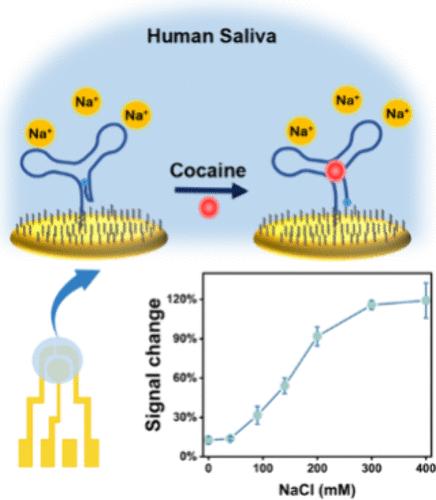基于电化学适体的人类唾液可卡因检测生物传感器:基质干扰的探索
IF 6.7
1区 化学
Q1 CHEMISTRY, ANALYTICAL
引用次数: 0
摘要
基于电化学适配体的生物传感器(e - aptassensors)是复杂生物流体即时检测(POC)的新兴平台。人类唾液尤其为检测可卡因等非法药物提供了一种非侵入性基质和前所未有的便利。然而,可卡因e -适体传感器的敏感性在唾液中明显受损。本文采用方波伏安法(SWV)研究了唾液成分对亚甲基蓝(MB)标记的经典可卡因适配体传感性能的影响,同时,我们报道了激光烧蚀制备的一次性可卡因e适配体传感器的开发和优化。利用循环伏安法(CV)、扫描电镜(SEM)和原子力显微镜(AFM)研究了一次性电极表面的清洁度和表面形貌。为了提高一次性平台的传感性能,我们开发了一种共固定策略,将目标和6-巯基-1-己醇(MCH)引入适配体固定溶液中,在适配体与MCH的比例为1:100时实现了最佳传感性能。在缓冲溶液中,我们发现适体传感器在低离子强度、缺乏多价离子和中性pH条件下表现最佳,而唾液成分(如粘度和粘蛋白)的影响最小。然而,在过渡到人类唾液后,唾液蛋白的存在对传感性能产生了深远的影响。为了减少这种影响,我们发现高NaCl浓度可以显著增强唾液中的感应反应。这种方法避免了离心和大量稀释,通过一种直接的“混合检测”方法,便于在人唾液中检测可卡因。该一次性配体传感器在90%唾液中的检测限(LOD)为3.7 μM,显示了电化学配体传感器在检测可卡因方面的巨大前景,特别是在通过吸烟给药的情况下。本文章由计算机程序翻译,如有差异,请以英文原文为准。

Electrochemical Aptamer-Based Biosensors for Cocaine Detection in Human Saliva: Exploring Matrix Interference
Electrochemical aptamer-based biosensors (E-aptasensors) are emerging platforms for point-of-care (POC) detection of complex biofluids. Human saliva particularly offers a noninvasive matrix and unprecedented convenience for detecting illicit drugs, such as cocaine. However, the sensitivity of cocaine E-aptasensors is significantly compromised in saliva. Herein, we investigated the influence of salivary components on the sensing performance of a methylene blue (MB)-labeled classic cocaine aptamer by square-wave voltammetry (SWV), and in parallel, we report the development and optimization of a disposable E-aptasensor for cocaine detection fabricated by laser ablation. Cyclic voltammetry (CV), scanning electron microscopy (SEM), and atomic force microscopy (AFM) were used to study the cleanliness and surface topography of the disposable electrode surface. To enhance the sensing performance of the disposable platform, we developed a co-immobilization strategy by introducing both the target and 6-mercapto-1-hexanol (MCH) into the aptamer immobilization solution, achieving optimal sensing performance at the aptamer-to-MCH ratio of 1:100. In a buffer solution, we revealed that the aptasensor performs best at low ionic strength, the absence of multivalent ions, and neutral pH conditions, while salivary components such as viscosity and mucin have minimal impact. However, upon transition to human saliva, the presence of salivary proteins exerted a profound effect on the sensing performance. To reduce this impact, we discovered that a high NaCl concentration could significantly enhance the sensing response in saliva. This approach circumvents centrifugation and extensive dilution and facilitates cocaine detection in human saliva through a straightforward “mix-and-detect” method. This disposable aptasensor achieved a limit of detection (LOD) of 3.7 μM in 90% saliva, demonstrating immense promise for the application of electrochemical aptasensors in detecting cocaine, especially when administered via smoking.
求助全文
通过发布文献求助,成功后即可免费获取论文全文。
去求助
来源期刊

Analytical Chemistry
化学-分析化学
CiteScore
12.10
自引率
12.20%
发文量
1949
审稿时长
1.4 months
期刊介绍:
Analytical Chemistry, a peer-reviewed research journal, focuses on disseminating new and original knowledge across all branches of analytical chemistry. Fundamental articles may explore general principles of chemical measurement science and need not directly address existing or potential analytical methodology. They can be entirely theoretical or report experimental results. Contributions may cover various phases of analytical operations, including sampling, bioanalysis, electrochemistry, mass spectrometry, microscale and nanoscale systems, environmental analysis, separations, spectroscopy, chemical reactions and selectivity, instrumentation, imaging, surface analysis, and data processing. Papers discussing known analytical methods should present a significant, original application of the method, a notable improvement, or results on an important analyte.
 求助内容:
求助内容: 应助结果提醒方式:
应助结果提醒方式:


